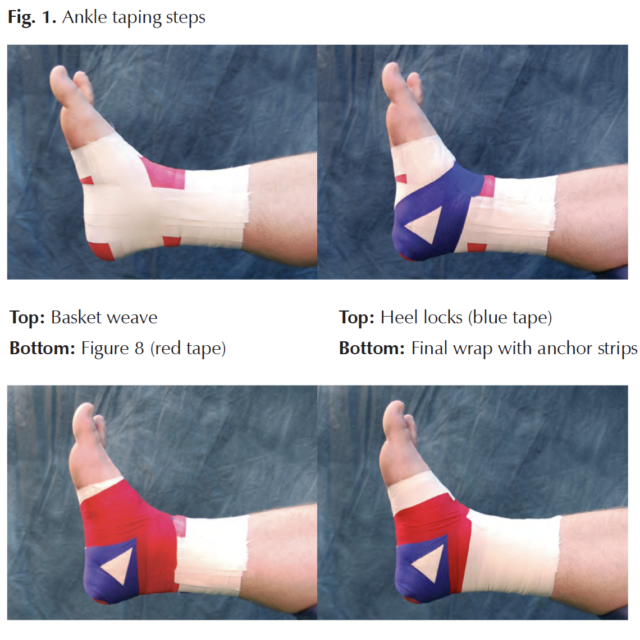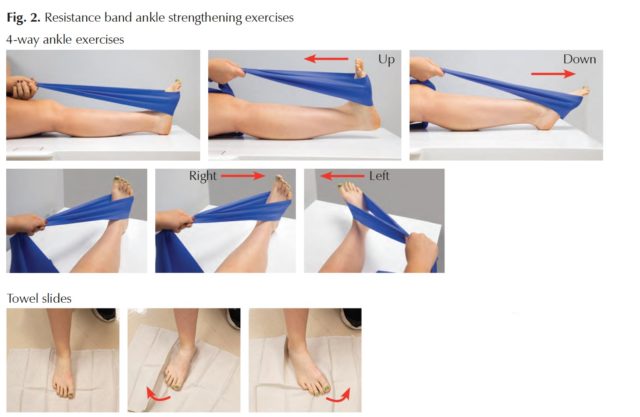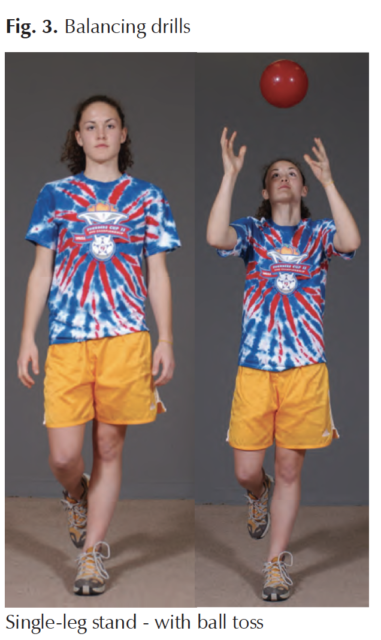
Ankle taping is commonly used in athletics, but why is it done? Initially, an athletic trainer may tape your ankle to help reduce the swelling that often occurs right after an injury. Later, taping the ankle provides the external stabilization that your stretched ligaments (tissues connecting bone to bone) need while they heal. Additionally, after you have completed rehabilitation and are ready to return to play, the athletic trainer may tape your ankle for extra support to avoid another injury.
The method used to tape your ankle depends on the type of injury you incurred. The most common type of ankle injury is an inversion (turning inward) ankle sprain (stretching or tearing a ligament). This occurs when the athlete’s ankle turns “in” or “under,” forcing the 5th digit (small toe) towards the ground. When this injury occurs, ligaments are stretched leaving the ankle unstable in the process. Once you have sprained your ankle, it will be more susceptible to sprains in the future because the stretched ligaments are weaker. This is where taping helps.

Taping after an inversion ankle sprain
The athletic trainer will first apply adhesive spray to hold heel and lace pads and a prewrap in place. The pads and prewrap protect the skin by reducing friction, which results in fewer blisters, and makes removing the tape easier and less painful. Next, a base layer of 1 to 3 pieces of tape, called anchor strips, are placed at the base of the calf muscle, half on the prewrap and half on the skin. The anchor strips do just what they imply; they anchor the tape by providing a base for the other tape pieces to stick. Then, the athletic trainer adds a series of alternating stirrup and horseshoe strips, forming a weave (Fig. 1). When the stirrup strips are done, they should form a fan shape to cover the malleoli (the bony projections at the ankle). The horseshoe strips provide the basic support needed at the sides of the ankle joint. Next, the trainer applies 2 heel-locks that keep the heel in place, slightly limiting motion and providing support for the ankle. Then the trainer places strips in the shape of a figure 8. Once these strips are in place, the athletic trainer finishes with multiple strips of tape placed in a circular motion similar to the anchor strips, ensuring that the taping application stays and does not unravel.

 Be proactive to prevent injury
Be proactive to prevent injury
Once you have an ankle injury, strengthening exercises and balancing drills can help you be proactive in preventing further harm. You should perform several repetitions of each exercise 2 to 3 times a day. The 4-way ankle strengthening exercise is performed by placing a resistance band on the ball of the foot, and then moving the ankle joint in an up and down, and side-to-side “t” pattern. Additionally, perform towel slides by placing a towel flat on a smooth surface, and then placing the foot at the end of the towel. Then use your foot to pull the towel to the left and then right (Fig. 2).
Similarly, restoring proper balance is important to reduce risk of injury as well by placing more outside forces on the ankle to help strengthen it. Balancing drills such as single-leg stands with increasing difficulty levels, adding ball tosses and unstable surfaces can help you regain confidence in your ankle and ability to balance (Fig. 3). When performing these exercises correctly, they enhance the ankle’s overall strength and decrease the likelihood of another injury.
A stabilizing effect
Ankle sprains are a common injury among athletes of all ages and level of participation. As a result, athletic trainers look for the best ankle stabilizer that will reduce injuries while minimizing the effect it may have on your performance. The ideal ankle taping method should be restrictive and comfortable while functional and protective. It should provide the extra support you need to feel confident in your return to play. Once you have completed all the necessary rehabilitation and regained confidence in your ankle, then taping may cease.
Author: Cassandra Bryant, MS, LAT, ATC | Columbus, Georgia
Author: Danielle Gunnin, MS, LAT, ATC, ITAT | Covington, Georgia
Vol. 30, Number 2, Spring 2018
Last edited on October 18, 2021